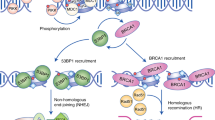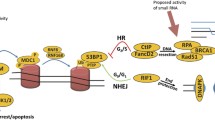Abstract
DNA strand breaks present a complex challenge for our cells, and the integrity of the DNA damage response machinery is critical for preventing cancer, premature aging, and neurodegenerative syndromes amongst other ailments. This multi-author review issue presents emerging topics relevant to understanding the fundamental structural mechanisms of DNA strand break sensing, signaling, and repair.
Similar content being viewed by others
Avoid common mistakes on your manuscript.
The DNA of all organisms is exposed to an unrelenting barrage of genomic insults. Endogenous processes, various sources of natural and unnatural ionizing radiation, and routine DNA metabolism all contribute to formation of abundant DNA strand breaks. Left unrepaired, DNA strand breaks can lead to mutagenic DNA translocations, genomic instability, contribute the evolution of cancer phenotypes, aging, neurodegeneration and other human health outcomes [1, 2]. During chemotherapy, we further employ agents that produce high loads of DNA damage in rapidly proliferating cancer cells. Thus, dissecting our cellular defenses to DNA damage, at the molecular level, is paramount for understanding the basic structural chemistry of the DNA damage response, and for improving therapeutic outcomes during chemotherapy.
DNA double strand breaks are accurately recognized, signaled and repaired by the homologous recombination (HR) repair machinery [3]. These complex molecular machines include the DNA damage sensing and processing Mre11/Rad50/Nbs1 complex, ATM and ATR kinases, BRCA1 and BRCA2 breast cancer susceptibility gene products, Rad51 recombinase, and heterotrimeric ssDNA binding Replication protein A complex. Owing to their size and complexity, a detailed molecular understanding of the function of these complexes has proved to be a formidable challenge. Recent advances in electron microscopic imaging technologies has propelled the field, and brought these assemblies into focus. Dr. Xiaodong Zhang and colleagues survey recent advances, both X-ray crystallographic and cryo-electron microscopic analyses of the homologous recombination machinery.
Targeting parallel DNA repair pathways in cancers already defined by an inactivation or misregulation of one of those pathways can act to selectively kill cancer cells [4,5,6]. To date, the most successful of these “synthetic lethal” treatment approaches has involved targeting the cellular poly (ADP)ribose polymerase. Dr. John Pascal and colleagues provide an overview of the structure and function Poly(ADP-ribose) polymerases and their roles in the maintenance of genome integrity.
In addition to their essential functions in replicating nuclear and mitochondrial genomes, the mammalian DNA polymerases are the work horses for DNA strand break repair processes. Humans are equipped with 15 DNA polymerases evolutionarily tuned for facilitating a variety of essential DNA strand break repair transactions. Dr. Bret Freudenthal and colleagues provide a comprehensive overview of the insights into human DNA polymerase functions gleaned from their structural characterization.
A robust DNA damage response is mounted when DNA sensors recognize DNA single and double strand breaks. These responses must discriminate deleterious DNA ends from critical structures such as telomeres which protect the ends of chromosomes. Chromosome ends maintain highly specialized structures that must evade the cellular DNA damage response in order to facilitate propagation of the genome and a cell death. Dr. Jayakrishnan Nandakumar and colleagues document the significant progress made in understanding the molecular mechanisms of chromosome end protection by Telomerase and the Shelterin complexes acting at chromosome ends.
A high burden of DNA damage in the form of DNA–protein crosslinks pose added, but still poorly understood threats to genomic integrity. Yet, inhibition of cellular DNA repair presents a set of exciting opportunities for development of novel therapeutics that sensitize cells to DNA damaging therapeutics that induce DNA protein crosslinks. Epipodophyllotoxins, such as etoposide and its derivatives remain frontline chemotherapeutic agents that trap cellular topoisomerase 2 (TOP2) reactions to create TOP2-DNA protein crosslinks (DPCs), potent cytotoxic lesions that trigger creation of DNA double strand breaks, genomic instability and apoptotic cell death in cancer cells. Dr. Riccio et al. summarize recent cell biological, biochemical, and protein structural advances documenting the identification of novel DPC repair factors, Tyrosyl-DNA phosphodiesterase 2 (TDP2) and the Zinc finger associated with TDP2 and TOP2 (ZATT) which directly engages TOP2-DPCs to facilitate DPC resolution.
Overall, significant progress has been made in our understanding of the structural chemistry of DNA damage response pathways. Broadly speaking, these advances define: (a) the molecular principles of susceptibility and resistance to commonly employed cancer chemotherapeutics and (b) the genetic determinants of DNA damage vulnerabilities. This series of reviews highlights the molecular insights into complex chemo-mechanical machineries dedicated to recognition, signaling, and repair of complex DNA strand breaks.
References
Andres SN, Schellenberg MJ, Wallace BD, Tumbale P, Williams RS (2015) Recognition and repair of chemically heterogeneous structures at DNA ends. Environ Mol Mutagen 56:1–21
Ciccia A, Elledge SJ (2010) The DNA damage response: making it safe to play with knives. Mol Cell 40:179–204
Williams RS, Williams JS, Tainer JA (2007) Mre11-Rad50-Nbs1 is a keystone complex connecting DNA repair machinery, double-strand break signaling, and the chromatin template. Biochem Cell Biol 85:509–520
Martin SA, Lord CJ, Ashworth A (2008) DNA repair deficiency as a therapeutic target in cancer. Curr Opin Genet Dev 18:80–86
Curtin NJ (2012) DNA repair dysregulation from cancer driver to therapeutic target. Nat Rev Cancer 12:801–817
Kaelin WG Jr (2005) The concept of synthetic lethality in the context of anticancer therapy. Nat Rev Cancer 5:689–698
Acknowledgements
This research was supported by the intramural research program of the US National Institutes of Health (NIH), National Institute of Environmental Health Sciences (NIEHS) Grant 1Z01ES102765 to R.S.W.
Author information
Authors and Affiliations
Corresponding author
Additional information
Publisher's Note
Springer Nature remains neutral with regard to jurisdictional claims in published maps and institutional affiliations.
Rights and permissions
About this article
Cite this article
Williams, R.S. Introduction to the multi-author-review: emerging advances in the structural chemistry of DNA strand break repair. Cell. Mol. Life Sci. 77, 1–2 (2020). https://doi.org/10.1007/s00018-019-03364-2
Received:
Revised:
Accepted:
Published:
Issue Date:
DOI: https://doi.org/10.1007/s00018-019-03364-2




